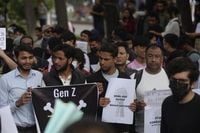On Sunday, October 12, 2025, Madagascar’s political landscape shifted dramatically as President Andry Rajoelina fled the country, marking the climax of weeks of intense, youth-led protests that had paralyzed the island nation. The protests, which erupted on September 25 over persistent water and electricity shortages, quickly morphed into a sweeping movement against corruption, mismanagement, and a chronic lack of basic services. According to Reuters, the departure of Rajoelina was confirmed by opposition leader Siteni Randrianassoloniako, who said, “We called the staff from the presidency and they confirmed that he had left the country.”
The president’s escape was anything but ordinary. Multiple sources, including French radio RFI, reported that Rajoelina departed Madagascar aboard a French military aircraft, following an agreement with French President Emmanuel Macron. The French military “Casa” plane landed at Sainte Marie Airport on Sunday, where Rajoelina was whisked away by helicopter before boarding the plane. The president’s office, which had previously announced that Rajoelina would address the nation on Monday evening, remained silent, declining to clarify his whereabouts or respond to mounting speculation about his fate.
As the president vanished from public view, Madagascar’s streets were anything but quiet. Thousands of protesters, most of them young and disillusioned, flooded the main square in the capital, Antananarivo, shouting “the president must quit now.” Their frustration was palpable. Adrianarivony Fanomegantsoa, a 22-year-old hotel worker, told Reuters, “In 16 years the president and his government have done nothing except enrich themselves while the people stay poor. And the youth, the Gen Z, suffer the most.” His monthly salary of 300,000 ariary—about $67—was barely enough to cover food, a stark reminder of the economic hardship faced by three-quarters of Madagascar’s 30 million people, as reported by the World Bank.
What began as a protest over daily hardships quickly spiraled into the most serious challenge to Rajoelina’s rule since his re-election in 2023. The movement was fueled by a new generation—Generation Z—who, emboldened by global youth uprisings, demanded transparency, inclusion, and a government that worked for the people. Their anger mirrored recent demonstrations in Morocco, Nepal, and Kenya, with protesters often sporting T-shirts and flags emblazoned with the skull-and-straw-hat symbol from the Japanese manga “One Piece”—a sign of the movement’s global reach and youthful energy.
Rajoelina’s isolation became complete when the elite CAPSAT military unit, which had helped him seize power in a 2009 coup, refused to shoot at protesters and instead joined their cause. Over the weekend before the president’s departure, CAPSAT announced it was taking control of the army and appointed a new chief of staff. “Exceptional situation, exceptional measures. And all the orders come from the gendarmerie command,” declared General Nonos Mbina Mamelison, who assumed leadership of the gendarmerie on Monday, as reported by India Today. The paramilitary gendarmerie, too, aligned with the protesters, formally taking control of their institution in the presence of senior state officials.
The power vacuum was further complicated by a dramatic shake-up in the government’s upper echelons. The president of the Senate—a frequent target of public ire during the protests—was relieved of his duties. Jean-André Ndremanjary was appointed as interim Senate leader, which, under Madagascar’s constitution, means he assumes the role of acting president until new elections can be organized.
Meanwhile, opposition members of Madagascar’s National Assembly signaled their intent to initiate impeachment proceedings against Rajoelina, according to Reuters. The sense of uncertainty was heightened by fears of a coup, especially as soldiers threatened to seize state television and Rajoelina’s planned address to the nation was abruptly canceled. A senior army general attempted to reassure the public, stating that security forces were working together to maintain order, even as live coverage of the crisis was paused amid mounting tension.
The cost of the uprising has been steep. At least 22 people have died in clashes between protesters and security forces since September 25, according to the United Nations. Yet, the sacrifices made by Madagascar’s youth echo those in other countries where Gen Z movements have toppled or shaken entrenched regimes. In Nepal, for example, the youth-led rebellion led to the resignation of the prime minister last month, though the aftermath has been fraught with division and uncertainty. The same pattern of youthful unity giving way to internal discord is now playing out in Madagascar’s own political transition.
Madagascar’s economic woes are deeply entrenched. The country, a former French colony, is best known for producing most of the world’s vanilla, but it also relies on exports of nickel, cobalt, textiles, and shrimp. Despite these resources, GDP per capita has plummeted 45 percent since independence in 1960. The median age is less than 20, and with poverty rates stubbornly high, it’s no wonder that the younger generation feels left behind.
The crisis in Madagascar is far from over. With the president in exile and the Senate leader stepping in as interim head of state, the path to new elections remains uncertain. The Gen Z movement, which galvanized so many to action, now faces the challenge of maintaining unity and focus amid the heady aftermath of their victory. The risk, as seen in Nepal, is that internal divisions could derail the promise of real reform and transparency for which so many have fought—and died.
As the dust settles, the world watches to see whether Madagascar’s youth can translate their unprecedented uprising into lasting change. The coming weeks will test whether the new leaders can deliver on the movement’s demands for a corruption-free, inclusive, and accountable government—or whether the opportunity for transformation will slip away amid the chaos of transition.

